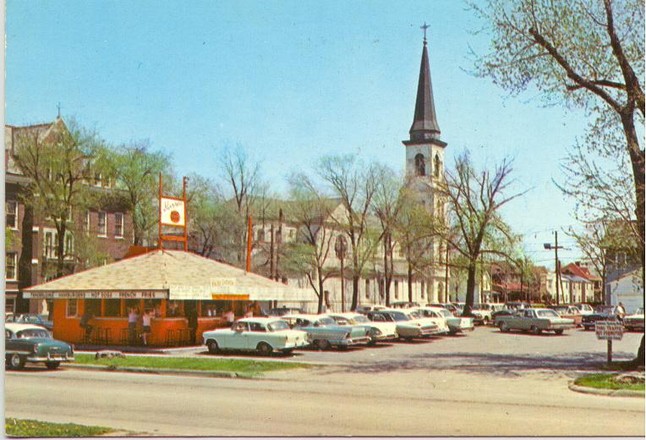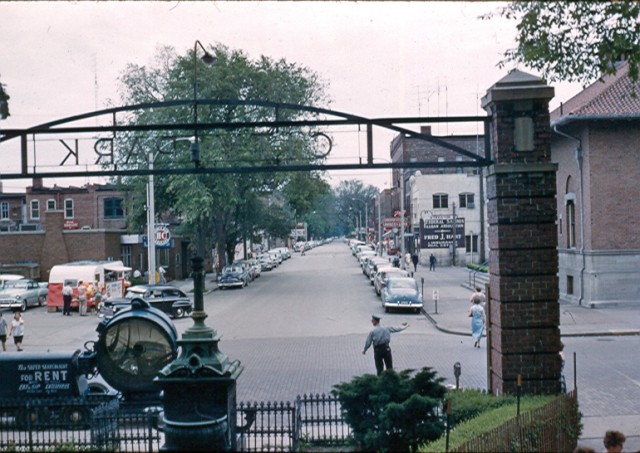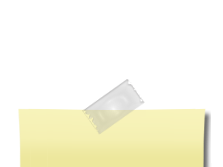Streator Past

In the days before “Oogies” and its famous strawberry pie, there was a little place everyone called “Nagles,” where you could buy a glass of root beer for just 5¢.
I attended St. Mary School, right across the street. We eagerly awaited the opening of Nagles in the springtime. We would watch for telltale signs, such as a fresh coat of orange paint, boxes of supplies stacked by the door, and new stripes on the parking lot. We would pester Bev Nagle for days, asking when she would be opening. On the big day, kids with money to spare would run across Kent Street at noon, competing to grab one of the stools at the counter, and place their order first. Those stools had wooden seats and steel legs, and I can still hear the sound of those legs scraping on the concrete.
I had money because I had a newspaper route, so I ate lunch at Nagles a couple times a week. The tenderloins were my choice. I ate them plain. I couldn’t stand onions, ketchup, mustard, or relish. Sometimes I would just eat french fries, but usually it was just a tenderloin, plain. The whole lunch cost about 50¢.
In high school, I started working for Jack Nagle in the summer of ‘63, selling ice cream and popsicles from a three-wheeled cart. These were cumbersome vehicles, subject to tipping over when turned at high speeds. They had one speed, big balloon tires, and a bulky aluminum cooler mounted on the two front wheels. A set of bells hung near the handle bar. I developed some good leg muscles pedaling these hulks all over town. The ice cream was kept cold with packs of dry ice, tied by Jack in brown paper.
Four kids usually worked each shift, pedaling routes which covered about a quarter of Streator’s area. I think there were two shifts a day. We made 2¢ on each bar we sold, and everything sold for 10¢. On a very good day, we made about $10. For holidays, extra carts would be sent out to parade routes and parks.
I certainly got to know Streator well; I traveled nearly every street in town at least ten times that summer. My first route started in Riverside. Bob Dieken, one of Jack’s senior employees (Bob was then 18), showed me the route on the first day. A little girl on Carroll Street was my most faithful customer. I always waited at her house, ringing the bells until she came out. The least favorite part of that route was those kids on Livingston Street who would lie in wait and throw green apples.
The ice cream carts operated out of a garage attached to the dry cleaners across the street from Nagles. Jack was in charge of the ice cream operation, and would schedule the kids, and get things started each morning. Working the ice cream carts was considered to be the best way to get a job at the root beer stand because you couldn’t work there until you were 15. It was important to prove to Jack that you were honest, dependable, and hard working.
The Nagles were very cool people. They had the first Thunderbird, a V-8 convertible, white with a red interior, that the kids said would go 120 miles an hour. They also had a cool house, with little touches of irreverence, such as Michelangelo’s statue of David with a tiny jock strap. Their sons were adventuresome boys. David Nagle was big and boisterous, full of good humor and jokes. Oogie was the opposite; tiny, wry, and, as it turned out, brainy. Everyone liked the Nagles.
In the summer of ’64, I asked Bev if I could work at the root beer stand. She hired me, and I started working 40 hours a week at the Silverfross. Lester Elias and I worked inside on the day shift. Les was a good partner; smart, talkative, and able to work hard. Our pay was 55¢ per hour. The kids who worked outside; taking orders and delivering food, got 50¢ per hour because they also got tips. My weekly paycheck was about $18 dollars, after taxes. The newspaper route was actually a better paying job, but I was tired of that kind of work.
Our day started about 8:00 a.m. First, we would clean up the counter area, put TSP in the rinse basins, and open up the shutters, which ran along the counter area. Business was slow in the morning; no one really came there for breakfast. Lunchtimes were busier, and everyone would be hopping. Afternoons were quiet, except on holidays and weekends.
My primary job was drawing drinks and shakes to fill out orders coming from the kitchen. I also collected the money from the carhops, and cleaned off trays and rinsed glasses. Carhops had to be especially careful to return all the glassware. Everyone’s favorite trophy was the baby root beer mug. Nagles never sold them, and the only way you could get one was to steal it.
The Animals released “House of the Rising Sun” that summer, and it became a number one record. I remember turning up the transistor radio so Bev could hear the song. She said, “What do you do to that?” I think I said something like, “You just exist and enjoy it, it’s not meant to be danced to.” It was the start of the English Invasion; Rock & Roll and old Blues tunes brought back to America by English bands. It was also the start of something else; the culture of the 60’s contrasting with the adults of another generation.
Employees could drink all the root beer they wanted, but you had to pay for food. I think there was a 5¢ employee discount on sandwiches. I never ate anything but plain tenderloins, and I couldn’t afford choices like the shrimp basket. I often rode my bike home for lunch, just for the variety.
A well-aged, gray-haired lady put the famous tenderloins together. She worked in a garage in an alley behind the Nagles’ house. Bev’s dad, a butcher from Grand Ridge, supplied the tenderloin slices. We must have been his best customer. He would deliver a supply every few days. The slices were laid out in aluminum pans, and kept in the cooler. Every day we would deliver a few pans to the gray-haired lady for her work. She mashed the tenderloin slices together using a piece of 1” galvanized pipe, threaded on each end. I remember that the pipe had masking tape on one end to protect her hands from the pipe threads. When the slices were amalgamated, she would bread the tenderloin, and lay it in the pan, separating each layer by wax paper. These were taken back to the coolers until needed.
Rose was the cook on the day shift. I don’t think she got along well with the gray- haired lady. Maybe that’s why they were separated. It was hot in the kitchen, but the coolers were heavenly. The root beer was contained in deep aluminum vats, covered with linen cloth. The smell permeated the room, mixed with the aroma of the breaded tenderloins. Jack mixed the root beer every night; that was one of his specialties.
I wasn’t the best employee. I was perhaps most famous for the blunders I made. My worst blunder was adding chocolate ice cream to the machine used to make vanilla shakes. This was bad news because vanilla was much more versatile and more in demand than chocolate. You couldn’t make a black cow or a strawberry shake with chocolate ice cream. The only solution was to clean out the machine and waste the whole mixture. I must have made this mistake three times, and Bev became more furious each time. It always seemed to happen just as the shift was changing, and customers would have to be told they couldn’t have their vanilla shakes or black cows. She would get so mad that she would even yell at Les Elias after she was done yelling at me. What a mess!
The night shift came on about 4:30 p.m. Jack Nagle took over then, and Andy Katchmar sometimes ran the night shift alone. He was definitely the best employee of that time; reliable, witty, resourceful, and capable. He and Bev got along very well. They loved talking together because they both had such quick minds. Night shift workers were older kids, who could work evenings. Nagles was often open late, especially on Friday and Saturday nights. The night shift kids never knew when they would come home.
In early 1965, I got a job at Kroger’s. The pay was great, and I didn’t go back to Nagles, but it was still part of my life. In later years, I often stopped for lunch when I was in town. For old time’s sake, I always took tray service in the parking lot. I’d pull under the canopy and say, “Give me a large root beer and a tenderloin, plain.” Thanks to the tradition the Nagles created, it was always the same, and always delicious.

The sound of an Amtrak train rolling though town.
The Norfolk and Western switch engine sitting on Bridge street , chugging away.
The clown in Super Dairy that would inflate and deflate by the front door.
The electronic sign that would flash $-$-$-$'s above the old SACI building, now the sign is for TOMkAT Roofing.
Spudnut Shop.
Dog 'N Suds.
Killer Hill.
The Super Dairy French Fries that they squeezed out of a large bottle.
Friday night dances at "The Hub".
Hills Bros soda fountain.
Being on a party telephone line
Stacy's Pool Room.
The ice cream truck that used to drive around Streator.
Vanilla or cherry cokes at Hills.
The fish in every department store pet area.
Jupiter’s.
The music section in Top Save (sinful!).
The mynah bird at Top Save.
The wood floors in Ace Hardware.
The smell of Owen's Illinois though the little windows along the alley.
Thompson's Food basket.
Klevers
Dog-n-Suds smells: fries, ketchup and root beer combined. Awesome!
Katchewan Lake
Pitsticks !!!!
Banana seat bikes.
Church bells (kept curfew for me).
The original Silverfross on the corner.
All the shoe stores on Main Street.
The bikers at Squints Zoo.
Collecting beer bottles on Sunday to cash in at Owen's.
Marx's for fireworks (an IDPH favorite).
The driving range just north of Rhema.
The driving range on Oakley Ave.
The miniature golf course at Westgate Plaza .
The tavern and junk yard across Main St. from the Westgate Plaza entrance where the canoe launch is now.
The Streator Armory at the SE corner of Main & Bloomington where Dick's is now.
The roller skating rink upstairs at the same corner.
Annie's Whore House
Watching a movie at the Drive-In.
raced on the 3rd St track.
The corner of Johnson and Bronson had Korals store, Tutkos groc, Lou and Dan’s and Bernard Sapecey (Not sure of the spelling) all on the same corner.
Rizzo's Motorcycle Shop by the Fire Station.
Sip N' Bite (Marshmallow Cokes that fizzed all over when stirred).
Jim's Cellar (Coffee Shop on East Main)
The Pumpkin wagons going to the Canning Factory (Where you would sneak behind the Wagon and Steal Pumpkins of the
Back).
Sweet Shop where Chef Tom's is located now.
Novotneys Cigar Store (Next to Cali "s East.) Smitty's Tavern on Main & Sterling.
Fishing Rodeos at Fekins Pond, where they tagged the fish on the tail and gave prizes to the kids for different categories.
Flip, “The most famous bartender". I remember him in the Stork Club, Paddocks, and where the south side Super Dairy was
located. Plus he probably worked at many more that I can't think of now.
The Church where Bulldog's is now located. High School Kids Used to eat their lunch on the steps.
Some tavern was located on Hawthorn Road (Hole in the Wall) and I heard there was one on Spring Lake road????
The go kart track out on East Livingston Rd. at the corner of Smith Douglas Rd.
Squint's Zoo (a tavern, not a fish store) and next to that was that record store. I don't remember the name but I bought tons of 45s there. On the corner of Bloomington and Hickory was Betty's Cafe. To the south of that was a doctor's office and then the infamous "Grandma's Lounge" , a strip joint.
The bus station at the Schultz Hotel and the Montgomery Ward tire store on Hickory St.
How about Rokey's?
The Indian Acres too.
Raids at the Grove and the Indian Acres.
Does anyone else remember Streator's “Woodstock "?
Opdyke's, Krystal's and Esther Kirk's if you had the money.
They use to block off Park Street in the winter for sledding.
The Granada Theatre on S. Monroe St.
Sears catalog and Hills Bros.
were at one time where Union Bank is parking is now.
How about the Woolworth’s food counter and
Murphy’s dime store food counter. It was
always a tradition to go shopping on a
Saturday and stop at either food counter for
a burger, fries and a soda or cup of coffee.
Hamburger Inn on Bloomington
St. where Times Press parking lot is now.
Going to J.C. Murphy's getting fresh candy from the center candy island in the store and then going to the Majestic.
The gas station north of Streator Lanes where a guy was murdered.
Oliver's Tavern.
Del Monte Tavern.
Dixie's (Yum) Pizza.
Big Boppers.
The little gas station at the four mile corner.
The Sinclair station.
Moon Creek Stories.
The flashing neon sign above the building on the SW corner of Bloomington and Hickory. It flashed alternately: "Need Cash Quick" "See Citizen Loan".
Skeet shooting out at the Pines.
The sound of an Amtrak train rolling though town.
The Norfolk and Western switch engine sitting on Bridge Street, chugging away.
The clown in Super Dairy that would inflate and deflate by the front door.
The electronic sign that would flash $-$-$-$'s above the old SACI building, now the sign is for TOMkAT Roofing.
Remember the Spudnut Shop?
Dog 'N Suds?
Killer Hill?
The Super Dairy French Fries that they squeezed out of a large bottle?
The pedal ice cream carts?
Circle Dairy.
Norris Hall. Now that was the place to go on a Friday and Saturday night!
Another Top Save memory was the cameras on the posts. They were like these Beta Panasonic M1's, automated to cover a section of the store. They would go side to side like "big brother" was watching you to make sure wouldn’t steal 8-tracks or something.
Harvest, Kosley, and Federal Bakeries.
2 tailor shops, one in Westgate Plaza, and the other on Sterling St.
Buelers Market (the best polish ham).
Grakos Market.
Eisenbart, Goslin, and Hudachko Drugstores
(for cinnamon oil to make toothpicks for school).
Trapps Bar and Dutch’s (great beef sandwiches).
Smitty’s tap, Arthurs Lounge, the Crescent Lounge, Rokey’s (that Freida thing).
Plumb, Grant, and Greeley Schools.
Ice skating at Marilla and Oakland Park.
Playing tennis in the city park.
The Polish picnics in Oakland Park.
The old bun haired head librarian @ the public library.... (mean... mean)!
Van Loons.
Rizzo's Barber Shop.
Airplanes pulling advertisement banners flying over Streator.
S&H Green stamps.
“Green River “soda fountain pop.
Snyder's Tavern that was at the SE corner of Hickory and Wasson.
The church where Bulldogs Restaurant is now
Oliver's Tavern
Del Monte Tavern
Dixie's (Yum) Pizza
Big Boppers
The little gas station at the four mile corner.
The Sinclair station.
The beauty school in the back of the Plumb Hotel.
The place where people went shooting opposite the dam. Man that place was FULL of shell casings and lead.
The flashing stars at Rudy's Supermarket.
The old Christmas decorations on Main Street which were green with all color lights and reached all the way across the street. They replaced them with horrible gaudy gold tinsel things. I think cheap looking candy canes were next.
Picking asparagus at Boznick's on First Street afterschool each day.
Going to Yeck's on Fuller Avenue and picking Pumpkins and throwing them on the Hay Racks for the canning factory. And
sneaking behind the wagons to steal a few pumpkins on the way to the canning factory.
Bowling Alleys had kids do Pin Setting, before the automatic Pin Setters were made.
Theaters had people wearing uniforms as ushers with the flashlight to seat you.
Sneaking Ice off the Ice delivery wagons.
Illinois Valley Milk delivery trucks.
When paper routes consisted of 150 or more papers , where it covered sections of the town rather than just a few blocks.
When Streator used to have Harvest Feasts.
When the railroad had towers or sheds for the men who operated the Gates.
The Morris Hotel by the train Depot and the bar.
Watching the fireworks and Circus at the Owen's Diamond. Rodeos at the south side diamond area.
Ace Hardware building near Spring Lake Road where they stored dynamite.
Marble tournaments at the school on Charles Street.
The train that ran to Chicago called the Doodle Bug?
What was the name of the hardware store that exploded from a natural gas leak? (Williams" Hardware)
Bomb shelters?
Scarratt's Deep Rock gas station at the corner of Bridge and Bloomington Street. Remember the revolving sign that they had on the corner?

